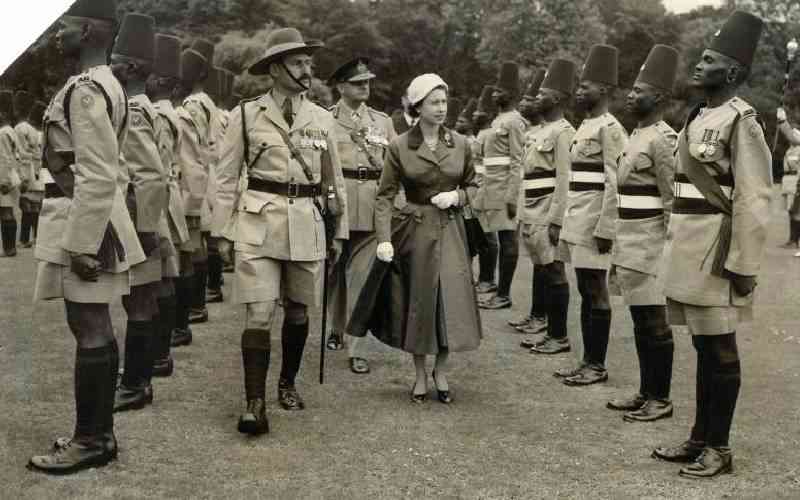
Her Majesty Queen Elizabeth inspecting a guard of honour mounted by the King's African rifles at Buckingham Palace Gardens in England, Britain on June 11, 1957. [File, Standard]
Away from the busy Nairobi-Nakuru Highway, lies the quiet town of Gilgil, not far from the Rift Valley and the Aberdares.
It has persevered the triumphant marching of valiant soldiers returning home from conquests and witnessed the laboured tiptoes of vanquished freedom fighters as they plotted to claw their way through a web of underground tunnels in desperate quests to return to their promised land.
But like an immovable mountain, Gilgil has silently watched as soldiers of all races passed through its dusty streets since the first batch of 400 Indian troops made a temporary camp in 1897.
They set base at Gilgil on their way from a mission in Sudan where they had gone to help the British suppress Mohammed Ahmad Ibin Abdalla after he and his men revolted against their rule by Egyptians on behalf of the British.
These soldiers were the first to be incorporated into the military when Kenya first became a territory and then a colony.
But the town's character from being a purely military base into a detention camp started during the First World War in 1914 and saw the confinement of Italian prisoners of war captured in Somalia.
According to historical records, these Italian prisoners were deployed in construction of Malewa and Morindat bridges, gravelled roads and built permanent military barracks in Gigil.
The town however gained international notoriety on March 2, 1947 when some 268 Israeli prisoners were transferred from Sambel detention camp in Eritrea to Gilgil. The prisoners had initially been captured in Palestine where they had been organising underground resistance against the British who wanted to gift the Promised Land to Arabs.
The Jews had tested the British patience by organising a series of jailbreaks only to be captured later.
Although Gilgil had in the past served as an impregnable prison for captured soldiers, it took the Jews just two weeks to stage their most successful jailbreaks.
There were no windows in the cells except tiny apertures near the roof, yet, the prisoners exploited the myriad sewerage conduits, tore down walls and ultimately broke out of the facility on March 29, 1947. They drove all the way to Uganda, where they obtained travel documents.
By the time The Daily Mail reported the escape, six Jews were safely in Belgium.
The Jews' nightmare ended on July 12, 1948, when 262 exiles from Gilgil landed in Tel Aviv to a heroic welcome in the newly established State of Israel.
 The Standard Group Plc is a multi-media organization with investments in media platforms spanning newspaper print
operations, television, radio broadcasting, digital and online services. The Standard Group is recognized as a
leading multi-media house in Kenya with a key influence in matters of national and international interest.
The Standard Group Plc is a multi-media organization with investments in media platforms spanning newspaper print
operations, television, radio broadcasting, digital and online services. The Standard Group is recognized as a
leading multi-media house in Kenya with a key influence in matters of national and international interest.











